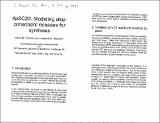Modeling stop-consonant releases for synthesis
Author(s)
Hanson, Helen M.; Stevens, Kenneth N.
Downloadhanson_asa_spring_2000_poster_scan.pdf (1.194Mb)
Terms of use
Metadata
Show full item recordAbstract
This study is part of a project leading to rule-based speech synthesis
using the HLsyn synthesizer. In HLsyn, stop-consonant releases are
generated by controlling the time variation of a constriction that is
formed by the lips, the tongue blade, or the tongue body. In order to
generate a consonant release that is perceptually acceptable and that
has acoustic characteristics that match those of normal speech, it was
found that the trajectory of the consonant release (cross-sectional
area versus time) had to exhibit an initial rapid rise, followed by a
delay in which the rise was interrupted, followed finally by a final
rise. The burst at the consonant release is generated by the airflow
through the constriction during the time that the rise is delayed. A
model of the time course of this three-stage release of the
articulator has been developed, taking into account the role of the
intraoral pressure, the tapering formed by the articulator, and the
glottal area. The model shows that the delay between the initial and
final area increases is progressively longer for labials, alveolars,
and velars, in agreement with acoustic data on the burst duration.
Description
Poster presented at the Spring 2000 Meeting of the Acoustical Society of America held in Atlanta, GA.
Date issued
2011-07-27Department
Massachusetts Institute of Technology. Research Laboratory of ElectronicsKeywords
stop consonants, speech synthesis
Collections
The following license files are associated with this item: